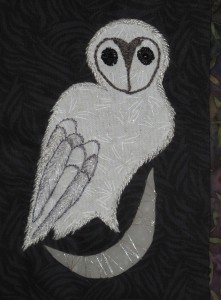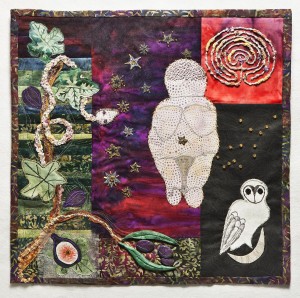Chapter Two
The second piece that tugged at me began with a double image: the Venus of Willendorf and a labyrinth. This was not an ornate cathedral labyrinth, but an ancient one that looks like a womb, a labyrinth that beckons one again into the place of birth.
As with the first piece, this one appeared on my inner screen fully formed, although “fully formed” is a strange description because the image changed as I began to sew. Yet each time it changed, it felt as if this version was complete…and that it had always had exactly that set of images. Although my first tiny sketch (an attempt to pin down what I was seeing) shows the labyrinth and a large central depiction of the woman, there is also a snake curling down along the left side and a crescent moon in the lower right. I remember thinking, Where did those come from? Somewhere between what I “saw” in my mind and what my fingers drew, those two symbols appeared.
Shortly before I cut the first piece of fabric, I decided to enlarge the sketch so that I could get a better sense of the proportions. In the process of taking a 1 ½” square sketch and making it 3″ square, I noticed that the snake had started to coil up the left side of the piece and was now wrapped around the branch of a fig tree, the crescent moon had become the perch for a snowy owl, and the Venus (or Woman) of Willendorf (still the central motif) had acquired 12 stars around the upper part of her body. And the image had a name: Havva: Mother of Life.
The process of sewing this piece was mysterious and mysteriously beautiful. With the same ease that the “shift” key had fallen into my hand, fabrics emerged from the stash I had collected over the years with no clear idea of its purpose since I have never been a quilter and the amount of fabric exceeded anything I would need for a lifetime of stoles! Shortly before the first piece appeared, I had discovered a fabric store near my home and had begun to acquire fat quarters in very particular color groupings, the very sky tones and earth tones that filled each of the pictures I was seeing.
Unlike Shift, the second piece began at the left and created itself from left to right, with the figs and the snake taking  shape first. The deep red-purple sunset sky came next, although the sky remained empty while the figs, the branch and the snake all became more and more detailed. Finally the Venus was ready to be cut, but her size had changed and her position had moved upward and to the right, no longer centered on the sky, but overlapping the place where the labyrinth and the owl would be. The background for the owl appeared, much larger than it had looked in the sketch and a constellation above it. I didn’t know which constellation, but when I offered Virgo as an option, that felt right.
shape first. The deep red-purple sunset sky came next, although the sky remained empty while the figs, the branch and the snake all became more and more detailed. Finally the Venus was ready to be cut, but her size had changed and her position had moved upward and to the right, no longer centered on the sky, but overlapping the place where the labyrinth and the owl would be. The background for the owl appeared, much larger than it had looked in the sketch and a constellation above it. I didn’t know which constellation, but when I offered Virgo as an option, that felt right.
Days elapsed while I tried to find the right background for the labyrinth which had to be in place before the Venus could be sewn on. I waited. A new branch grew off the fig tree (and sprouted olives!), the owl was sewn and pinned in place when (finally) the background for the labyrinth fell out of my stack of fat quarters…not earth-toned at all, but a brighter version of the central sunset sky.
The Venus slipped into place and the stars I had seen around her head scattered over the whole of the sky, issuing from the mouth of the snake to arc around her head and body. It was in the midst of sewing the gold beads onto the stars that the piece crossed a tipping point and – in the only words I can find that begin to describe the feeling – “knew” itself and, in that moment, it spoke quite clearly and informed me that its name was not Havva: Mother of Life. The words were, “This is not my name.” I don’t know which of us was more startled.
Meanwhile, a different piece from that original set of six images was looking for some words by Hildegard of Bingen that I had seen written along one side. I remembered the phrase, “like a feather on the breath of God,” but could not remember the whole of the quotation, so I started into a web search. The web was still alien territory to me and I used it haltingly, so I was scrolling through several sites when I stumbled on a poem that I had never read before and the words came right off the computer screen. The poem is “Ave Generosa” and it begins:
I behold you,
noble, glorious and whole woman,
the pupil of purity.
You are the sacred matrix
in which God takes great pleasure.
[Click on the image to enlarge it.]
Matrix. I ran from the computer to the door on which the piece was hanging and said, “You are Matrix; that’s your name.” I felt the same whirr-click I had felt with Shift. The piece radiated delight. It was only later, when I looked up the word, matrix, in the OED that I learned that it comes from the latin root meaning, womb.
So chapter two became a chapter about centering, about returning to the womb and being born anew.
Read more Chapters Three and Four
